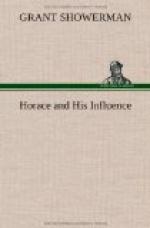H_ail! Sovereign of the lyric measure_,
H_ail! Italy’s great pride
and treasure_;
and, after recounting the qualities of the poet, and acknowledging him as guide, teacher, and lord, concludes:
Tanto e l’ amor che
a te m’avvince; tanto
E degli affetti
miei donno il tuo canto—
S_o great the love that bindeth me to
thee_;
S_o ruleth in my heart thy minstrelsy_.
But Petrarch is a torch-bearer so far in advance of his successors that the illumination almost dies out again before they arrive. It was not until well into the fifteenth century that the long and numerous line of imitators, translators, adapters, parodists, commentators, editors, and publishers began, which has continued to the present day. The modern-Latin poets in all countries were the first, but their efforts soon gave place to attempts in the vernacular tongues. The German Eduard Stemplinger, in his Life of the Horatian Lyric Since the Renaissance, published in 1906, knows 90 English renderings of the entire Odes of Horace, 70 German, 100 French, and 48 Italian. Some are in prose, some even in dialect. The poet of Venusia is made a Burgundian, a Berliner, and even a Platt-deutsch. All of these are attempts to transfuse Horace into the veins of modern life, and are significant of their authors’ conviction as to the vitalizing power of the ancient poet. No author from among the classics has been so frequently translated as Horace.
Petrarch, as we have seen, led the modern world by a century in the appreciation of Horace. It was in 1470, ninety-six years after the laureate’s death, that Italy achieved the first printed edition of the poet, which was also the first in the world. This was followed in 1474 by a printing of Acro’s notes, grown by accretion since their origin in the third century into a much larger body of commentary. In 1476 was published the first Horace containing both text and notes, which were those of Acro and Porphyrio, and in 1482 appeared Landinus’s notes, the first printed commentary on Horace by a modern humanist. Landinus was prefaced by a Latin poem of Politian’s, who, with Lorenzo dei Medici, was a sort of arbiter in taste, and who produced in 1500 a Horace of his own. Mancinelli, who, like many other scholars of the time, gave public readings and interpretations of Horace and other classics, in 1492 dedicated to the celebrated enthusiast Pomponius Laetus an edition of the Odes, Epodes, and Secular Hymn, in which he so successfully integrated the comments of Acro, Porphyrio, Landinus, and himself, that for the next hundred years it remained the most authoritative Horace. In Italy, between 1470 and 1500, appeared no fewer than 44 editions of the poet, while in France there were four and in Germany about ten. Venice alone published, from 1490 to 1500, thirteen editions containing text and commentary by “The Great Four,” as they were called. The famous Aldine editions began to appear in 1501. Besides Venice, Florence, and Rome, Ferrara came early to be a brilliant center of Horatian study, Lionel d’Este and the Guarini preparing the way for the more distinguished, if less scholastic, discipleship of Ariosto and Tasso. Naples and the South displayed little activity.




